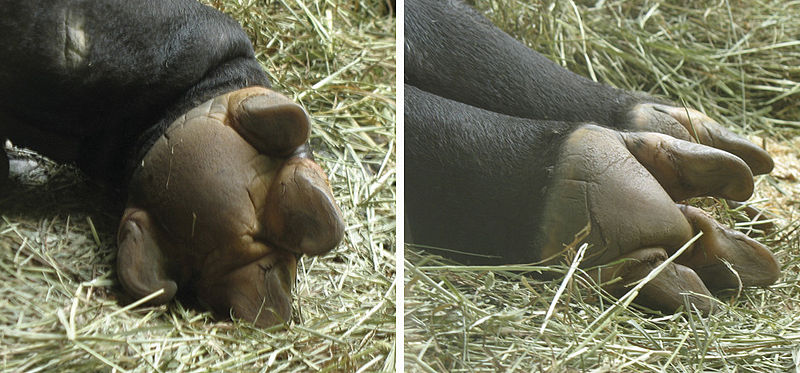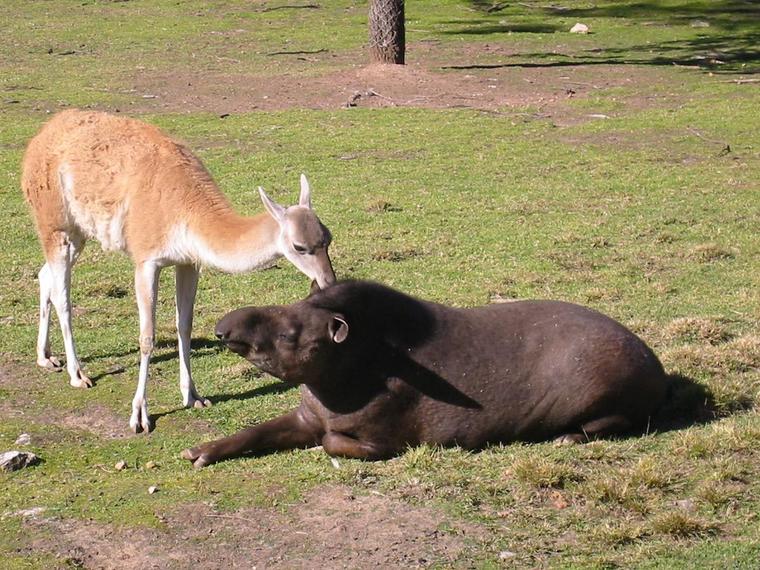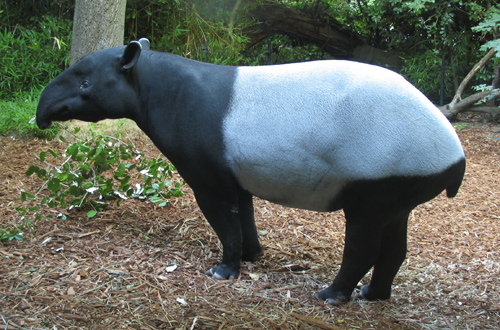TAPIR
I'm surprised this hasn't been done yet. (Unless it has, and I missed it?)

Tapirs (pronounced /ˈteɪpɚ/, as in "taper", or /təˈpɪər/, as "ta-pier") are large browsing mammals, roughly pig-like in shape, with short, prehensile snouts. They inhabit jungle and forest regions of South America, Central America, and Southeast Asia. All four species of tapir are classified as endangered or vulnerable. Their closest relatives are the other odd-toed ungulates, including horses and rhinoceroses. The tapir is the largest land mammal of Central America. Known as the "mountain cow" in Belize, they are forest dwellers, active mostly at night as they forage along river banks and forest clearings.


All tapirs have oval, white-tipped ears, rounded, protruding rear ends with stubby tails, and splayed, hoofed toes, with four toes on the front feet and three on the hind feet, which help them walk on muddy and soft ground.

(their front and hind feet)
Although they frequently live in dryland forests, tapirs with access to rivers spend a good deal of time in and under the water, feeding on soft vegetation, taking refuge from predators, and cooling off during hot periods. Tapirs near a water source will swim, sink to the bottom and walk along the riverbed to feed, and have been known to submerge themselves under water to allow small fish to pick parasites off their bulky bodies.[15] Along with fresh water lounging, tapirs often wallow in mud pits, which also helps to keep them cool and free of insects.

(A tapir and a guanaco)
Adult tapirs are large enough that they have few natural predators, and the thick skin on the backs of their necks helps to protect them from threats such as jaguars, crocodiles, anacondas, and tigers. The creatures are also able to run fairly quickly, considering their size and cumbersome appearance, finding shelter in the thick undergrowth of the forest or in water.

Tapirs are generally shy, but when they are scared they can defend themselves with their very powerful jaws. In 1998, a zookeeper in Oklahoma City was mauled and had an arm severed by a tapir bite, after she attempted to feed the attacking tapir's young. In 2006, a 46-year-old man (who was the Environmental Minister at the time) who was lost in the Corcovado National Park at Costa Rica was found by a search party with a "nasty bite" from a wild tapir. However, such examples are rare; for the most part, tapirs are likely to avoid confrontation in favor of running from predators, hiding, or, if possible, submerging themselves in nearby water until a threat is gone.
There are four species of tapir:
Baird's Tapir

Malayan Tapir

Brazilian (Lowland) Tapir


Mountain (Andean) Tapir

Baby tapirs of all types have striped-and-spotted coats for camouflage.




THIS LOOKS LIKE SOMETHING FROM STAR WARS.

Tapirs (pronounced /ˈteɪpɚ/, as in "taper", or /təˈpɪər/, as "ta-pier") are large browsing mammals, roughly pig-like in shape, with short, prehensile snouts. They inhabit jungle and forest regions of South America, Central America, and Southeast Asia. All four species of tapir are classified as endangered or vulnerable. Their closest relatives are the other odd-toed ungulates, including horses and rhinoceroses. The tapir is the largest land mammal of Central America. Known as the "mountain cow" in Belize, they are forest dwellers, active mostly at night as they forage along river banks and forest clearings.


All tapirs have oval, white-tipped ears, rounded, protruding rear ends with stubby tails, and splayed, hoofed toes, with four toes on the front feet and three on the hind feet, which help them walk on muddy and soft ground.

(their front and hind feet)
Although they frequently live in dryland forests, tapirs with access to rivers spend a good deal of time in and under the water, feeding on soft vegetation, taking refuge from predators, and cooling off during hot periods. Tapirs near a water source will swim, sink to the bottom and walk along the riverbed to feed, and have been known to submerge themselves under water to allow small fish to pick parasites off their bulky bodies.[15] Along with fresh water lounging, tapirs often wallow in mud pits, which also helps to keep them cool and free of insects.

(A tapir and a guanaco)
Adult tapirs are large enough that they have few natural predators, and the thick skin on the backs of their necks helps to protect them from threats such as jaguars, crocodiles, anacondas, and tigers. The creatures are also able to run fairly quickly, considering their size and cumbersome appearance, finding shelter in the thick undergrowth of the forest or in water.

Tapirs are generally shy, but when they are scared they can defend themselves with their very powerful jaws. In 1998, a zookeeper in Oklahoma City was mauled and had an arm severed by a tapir bite, after she attempted to feed the attacking tapir's young. In 2006, a 46-year-old man (who was the Environmental Minister at the time) who was lost in the Corcovado National Park at Costa Rica was found by a search party with a "nasty bite" from a wild tapir. However, such examples are rare; for the most part, tapirs are likely to avoid confrontation in favor of running from predators, hiding, or, if possible, submerging themselves in nearby water until a threat is gone.
There are four species of tapir:
Baird's Tapir

Malayan Tapir

Brazilian (Lowland) Tapir


Mountain (Andean) Tapir
Baby tapirs of all types have striped-and-spotted coats for camouflage.




THIS LOOKS LIKE SOMETHING FROM STAR WARS.